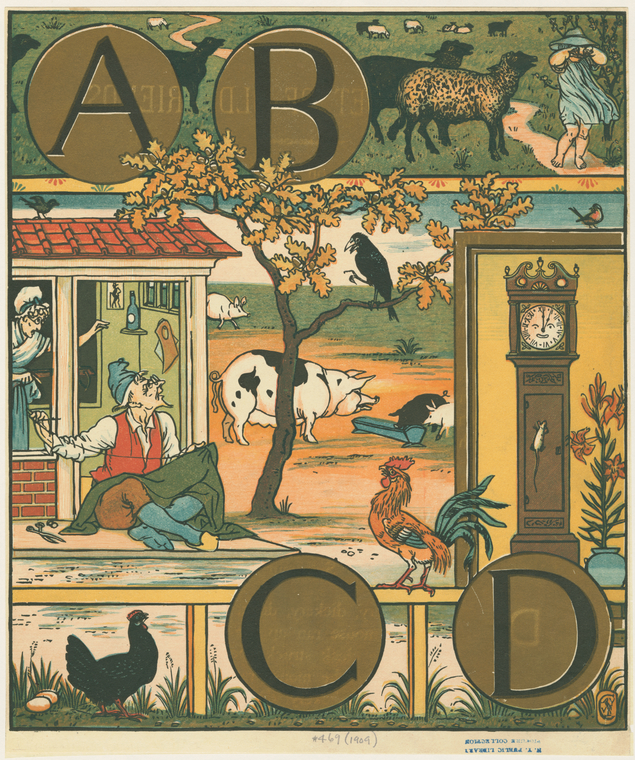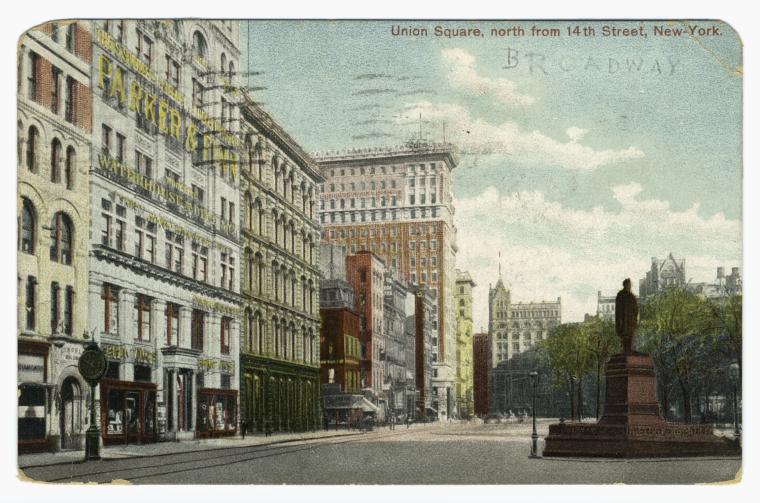"A is for Aye-Aye": How Filmmaker Augusta Palmer Uses the Picture Collection
Like an animated alphabet book, the film A is for Aye-Aye: An Abecedarian Adventure captures images from the alphabetized subject headings of the New York Public Library Picture Collection to create a world that comes to life one letter at a time. Augusta Palmer’s 14-minute film uses a library resource as the jumping off point for a child’s imagination.

In the film, the rows of black folders on the shelves before Iris, the 9-year-old protagonist, are a bit intimidating at first glance. How does Iris begin here? She looks around at the adults in the room for help. There are two approaches: She can wander back and find a subject that interests her, grab the folder, and let serendipity take her; or, she can ask the librarian at the desk for help with a subject.
Lucky for us, when Iris enters the collection, imagination wins! A is for Aye-Aye takes us on an adventure that captures all the glory of inspiration that can be gathered and manipulated from this diverse collection of pictures. We asked filmmaker Augusta Palmer a few questions about her ideas for the film:
Where did the idea for your film A is for Aye-Aye begin?
I fell in love with the Picture Collection when I was still in my twenties, but the idea for the film started to percolate when my oldest child, Laila, was starting to read in 2010.
I suddenly thought, why not make an ABC film using images from the Collection. It took quite a few years, two Kickstarters and great collaborators like animator Sabina Hahn, who brought so much of her own vision to the piece. When she was 9, my daughter became the star of the film, so her collaboration and inspiration were essential.
Why did you use a child's perspective in the film? Did you ever use the Picture Collection when you were a kid?
I grew up in Little Rock, Arkansas, so I couldn't go to the Picture Collection as a kid. The downtown library in Little Rock was one of my favorite places, and one of the first places I was allowed to go on my own.
It was a real refuge for me, and that's the experience I wanted to convey and the reason I used a child's point of view. I just wanted to celebrate creating a whole world in your mind at the library. That, combined with experiences I had at the Picture Collection. Someone really did raise a magnifying glass and look at me through it one day, just as happens to the girl in the film.
A is for Aye-Aye uses hundreds of pictures to create the animation in the movie. How did you choose the images?
I really just chose images that attracted my eye and my mind from each letter. It was very intuitive. I made quite a lot of collages to start. Later on, animator Sabina Hahn used those as a jumping-off point but also found images I'd overlooked and brought in her own great taste and ideas about movement.
Music also plays an important role in the film. How did you and Greg Karnilaw, the composer, come up with the score?
I've known Greg for over 20 years now and I really trust his instincts. He scored a documentary I co-directed with my husband, Chris Arnold, called If You Succeed and, from that point on, I saw that he always saw another layer beyond what I see in a given scene. He really got that the film is about play and about interiority, and the score reflects that in an amazing way.
He began composing before the film was finished and was like a master tailor, shortening and lengthening pieces to fit the completed film. One of my favorite parts of making the film was watching the musicians record the score; it was amazing to hear and see!
Do you have a favorite folder or subject in the Collection?
It's not in the film, but I love that there are folders labeled "Dead, The" with all kinds of funeral imagery. I love the folders on music and all the beaches folders, as well as the many place folders, like the one for the Gilbert Islands. And, naturally, I love Book Illustrations - ABC Books.
Appropriately, A is for Aye-Aye begins with a girl arriving at the library in front of the Schwarzman Building. She crosses the street to the Mid-Manhattan Library to begin her adventure in the Picture Collection. The film ends with the girl musing with the aye-aye back in front of the Schwarzman Building, foreshadowing the Picture Collection’s relocation to where it began 103 years ago.
 When the New York Public Library opened in 1911, patrons began requesting pictures of things. They often didn’t need a whole book on Abraham Lincoln, and they didn’t necessarily know who had photographed him, they just wanted to see a picture of him, or of a platypus, or it could have been Union Square.
When the New York Public Library opened in 1911, patrons began requesting pictures of things. They often didn’t need a whole book on Abraham Lincoln, and they didn’t necessarily know who had photographed him, they just wanted to see a picture of him, or of a platypus, or it could have been Union Square.
In response, librarians began collecting pictures of things as requested by the public and the Picture Collection was slowly built in the stacks off of the cataloging room at the time, Room 100. The Collection was pieced together by requests from the public like, "I need a picture of a solar eclipse" or "people treading grapes." The librarian would file the request and let the patron know when they had found a picture to suit the need.
During the 1930s, Works Progress Administration (WPA) workers began filling the Collection files with pictures from newspaper and magazine sources and it grew rapidly. It began with 23,500 pictures and boasted over 2 million in the 1940s. It moved from its beginning in Room 100, to the ground floor of the Central Building, where it eventually overflowed the boundaries of its assigned space into the adjacent hallway.
By the early 1980s, the Collection moved again, given a new home and a new shelving system at the Mid-Manhattan Library across the street. It resided in this space for about 35 years until the summer of 2017 when it moved back to the Stephen A. Schwarzman Building at 5th Avenue and 42nd Street. Once again happily housed in Room 100, the Picture Collection still collects pictures, notes their sources, and files them by subject for the inspiration of anyone doing image research.
Join us for A is for Aye-Aye workshops with Augusta Palmer in December in the Picture Collection:
Build a World: Film screening and Collage Workshop
Wednesday, December 12, 2018, 4 PM, all ages
Inspired by the collages of filmmaker Augusta Palmer’s A is for Aye-Aye: An Abecedarian Adventure, workshop participants will create their own collages on paper using elements collected from the NYPL Picture Collection. Will your collage create a sense of play between line, color, and form? Will it create an imaginary space that could host a series of mysterious events? Or an expected character who inhabits your new world?
Build Your Own Beast: Film screening and Stop Motion Animation Workshop
Saturday, December 15, 2018, 11 AM, children’s workshop
After watching A is for Aye-Aye: An Abecedarian Adventure, workshop participants will create their own characters using elements from the collection. Kids will work together to create a short stop-motion animation featuring their new creations.
Read E-Books with SimplyE
 With your library card, it's easier than ever to choose from more than 300,000 e-books on SimplyE, The New York Public Library's free e-reader app. Gain access to digital resources for all ages, including e-books, audiobooks, databases, and more.
With your library card, it's easier than ever to choose from more than 300,000 e-books on SimplyE, The New York Public Library's free e-reader app. Gain access to digital resources for all ages, including e-books, audiobooks, databases, and more.
If you don’t have an NYPL library card, New York State residents can apply for a digital card online or through SimplyE (available on the App Store or Google Play).
Need more help? Read our guide to using SimplyE.


